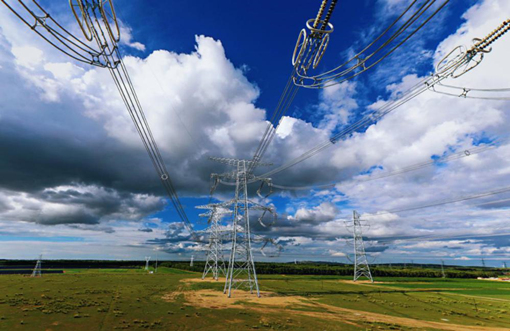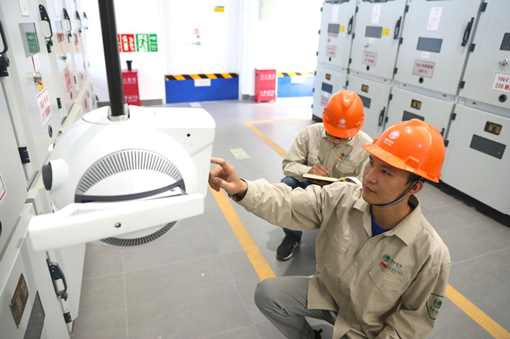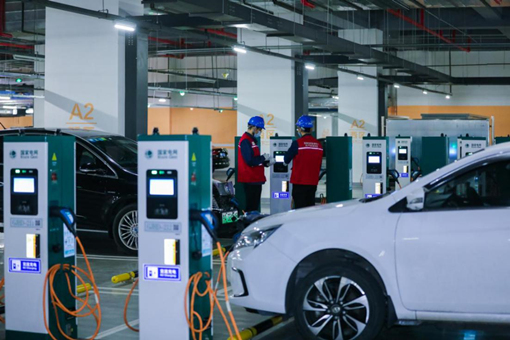from:China Electricity Councildate:2021-02-24
With supporting power grid projects completed in Zhangjiakou and Beijing, venues for Beijing 2022 Olympic and Paralympic Winter Games are supplied with a steady flow of wind and solar power. China is delivering on its promise of hosting green Olympics.
Committing to 100% Green Power Makes Olympic History
The New Shougang High-end Industry Comprehensive Service Park (“Shougang Park”), located at the west end of Chang’an Avenue and next to the Yongding River and Shijingshan Mountain, is truly a hub for ice and snow sports. As the headquarters of the Beijing Organizing Committee for the 2022 Olympic and Paralympic Winter Games, Shougang Park is also home to short track speed skating, figure skating, curling, and ice hockey training venues dubbed “Four Ice Cubes” as well as the Diving Tower.
From a steel mill with sparkling molten metal to a full-featured Winter Olympic base, the shift of the Shougang Park represents a turn of an era. To bring back a blue sky prior to the Beijing 2008 Summer Olympics, the No. 5 Blast Furnace, a witness to Shougang’s glory, was removed on June 30, 2005. On that day, employees of Shougang Group gathered to bid farewell to the furnace. Today, the deserted factory has taken on a new look to shoulder its new historical mission.
The signing ceremony for green power supply to Beijing 2022 took place there on January 30, 2019, and made it clear that all 26 venues in three competition zones would be powered by green energy. On the same day, new energy providers including China Huadian Corporation Ltd. and Beijing Jingneng Power Co., Ltd. signed preliminary agreements with Winter Olympic venues.

Zhangbei-Xiong’an 1,000kV UHV AC Transmission and Transformation Project passes through Zhangbei Substation
The day marked a milestone: for the first time in Olympic history, all venues would be supplied with 100% green power. Juan Antonio Samaranch, Vice-President of the International Olympic Committee and Chair of the Coordination Commission for the XXIV Olympic Winter Games Beijing 2022, said that such green efforts would be a new highlight of Beijing Winter Olympics.
Zhang Jiandong, Vice Mayor of Beijing and Executive Vice President of the Beijing 2022 Organizing Committee, believes that the use of green power in venues is making good on Beijing’s promise to host green Olympics, which is instrumental in China’s clean energy drive and ecological progress.
Facilitating Generation and Delivery of Green Power
Where is the green power from, and how is it supplied to Olympic venues?
“The gale blows once a year, lasting from spring to winter.” The folk saying mirrors the hostile natural environment in Zhangbei, but it also implies rich wind power resources. Currently, the world’s energy structure is undergoing profound changes, with revolution towards clean, low-carbon, and efficient energy already under way. On July 29, 2015, the State Council approved the establishment of a renewable energy demonstration zone in Zhangjiakou in response to the Zhangjiakou, Heibei Renewable Energy Demonstration Zone Development Plan. Accordingly, Zhangjiakou needs to develop three types of renewable energy projects, namely, 10GW-level wind power bases, large-scale photovoltaic power bases, and high-temperature solar thermal power projects, while their installed capacity will reach 20GW,24GW and 6GW by 2030, respectively.

The Shijingshan power supply company of State Grid Beijing Electric Power Company inspects power equipment for the Winter Olympics with smart robots
The green power generated must be delivered. With the implementation of the Smart Grid Planning for Low-Carbon Olympics, supporting power grids in three competition zones of Beijing, Yanqing, and Zhangjiakou, and the Zhangbei Renewable Energy Flexible DC Grid Pilot and Demonstration Project, are in place and form an energy internet demonstration highlighting “smart grid + clean energy”. A strong, smart, clean, and efficient grid will channel a steady flow of green power to Olympic venues, underpinning low-carbon Games.
Apart from the visible green power grid, an invisible green power trading network is also playing its part. On December 18, 2020, the reporter visited Jibei Power Exchange Center, where various power trading data were displayed on a screen in real time. The head of the center told the reporter that at year end when generation enterprises negotiated annual contracts with clients, clean energy was sold directly to clients after bidding through the center under a government-grid-generator-client cooperation(“four-party mechanism”), to meet their needs such as heating.
The National Development and Reform Commission issued the Policy Proposal on Clean Heating Price in North China in September 2017.To encourage market-based trading, it stipulated among others that, for heating power traded on electricity market, the transmission and distribution price in the off-peak period shall be 50% of that in normal hours. In November 2017, the four-party mechanism was first implemented through Jibei Power Exchange Platform after rounds of negotiation led by the Zhangjiakou municipal government, pioneering the market-based trading of renewables in China. Under this mechanism, the joint participation in electricity marketer moves systemic barriers in accommodating renewables, achieving economic, ecological, and social benefits.
The Rules for Market-Based Trading of Green Power in Beijing, Tianjin, and Hebei (Trial), China’s first set of rules for green power trading, were issued in November 2018. According to the rules, renewable electricity beyond the guaranteed purchase hours should be traded on the market, while the green power trading between Winter Olympic venues and new energy generation enterprises are given priority.
Marketisan invisible hand bringing generators and users together. On the one hand, enterprises participating in such trading could gain economic benefits while fulfilling social responsibility and promoting new energy; on the other hand, Winter Olympic venues could save power costs and meet low-carbon commitment. The power exchange center plays a fundamental role in power resource allocation and clean energy accommodation, and serves as the channel for fair, open, predictable, and smooth transactions.
On July 1, 2019, the power trading for Winter Olympic venues in Beijing was launched. The first seven venues and auxiliary facilities thus gained access to green power. “From 2019 to 2020, the organizing committee plans to seal deals for all Olympics-related power used during venue construction, trial events and official events, totaling around 700GWh of green electricity,” said the head of the green power trading work group under State Grid leading group for Winter Olympics.
Green Power for Green Olympics
On the morning of December 10, 2020, the reporter visited the 110kV Haituo Substation located in the Xiaohaituo Mountain in Yanqing District, Beijing. The substation, a split-level building utilizing mountainous terrain, is powered by green electricity from roof-top photovoltaic panels. “This substation is located in the core zone of Winter Olympic venues. We built the exterior walls with stones excavated during its construction, which are not only beautiful but also environment-friendly,” said Guan Tao, CTO of Yanqing Power Supply Company.
Green Olympics is a concept upheld by State Grid throughout the planning, construction and operation processes. “The company is building an energy internet innovation demonstration zone featuring ‘smart grid + UHV grid + clean energy’ based on the unique advantages of Beijing and Zhangjiakou in resource and location, so as to provide safe, reliable, and clean power support for the Winter Olympics,” said Gu Yi, director of the second planning division under the Department of Development and Planning of State Grid.

Staff from State Grid Beijing Electric Power Company maintaining the charging facilities in the underground car park of Wukesong Sports Center
State Grid built Beijing's largest centralized electric vehicle (EV) charging station at the underground car park of Wukesong Sports Center, and put into operation on May 15, 2020. The 80 sets of 60kW DC charging pile and 120 sets of 7kW AC kind could provide charging service to a maximum of 1,300 EVs on a daily basis. This year, as part of the efforts to new infrastructure construction, State Grid Beijing Electric Power Company added 1,187 sets to its charging pile construction plan in addition to the original 1,632. The 2,819 charging piles will cover Beijing Municipal Administrative Center, areas around the Winter Olympic venues, service areas of the Beijing-Chongli Expressway, and Beijing Daxing International Airport Economic Zone, contributing to the development of charging facilities and EVs.
As of now, State Grid has built 326 charging piles around the Olympic venues in the Beijing competition zone, completed a demonstration station integrating photovoltaic generation, energy storage and charging in the Yanqing competition zone, and built 720 charging piles for 107 charging stations in Zhangjiakou and along expressways nearby, easing clean transportation in the regions.
Ensuring good air quality in competition zones and surrounding areas is China’s commitment to international community and the wish of local residents. From 2018 to 2020, State Grid has replaced coal with electricity in heating for 8.63 million households in North China, covering 679 million square meters of heating areas which consumed a total of 24.9TWh. Combined with the 20.7TWh predicted for 2020-2021 heating season, the electricity used to replace coal since 2018 would increase to 45.6TWh, equivalent to saving 25.33 million metric tons of coal, reducing emissions of carbon dioxide by 45.49 million metric tons, sulfur dioxide by 1.37 million metric tons, nitrogen oxides by 680 thousand metric tons and air dust by 12.4 million metric tons, contributing significantly to the Blue Sky Protection Campaign.
The Beijing 2022offers State Grid an opportunity to power green Olympics. With the Games around the corner, preparation is in full swing. Run on the most reliable, economical and efficient green power, the Winter Olympics will present the world with a beautiful China committed to green, low-carbon development.
Tel:+86-25-84152563
Fax:+86-25-52146294
Email:export@hbtianrui.com
Address:Head Office: No.8 Chuangye Avenue, Economic Development Zone, Tianmen City, Hubei Province, China (Zip Code: 431700) Nanjing Office: Room 201-301, Building K10,15 Wanshou Road,Nanjing Area, China (Jiangsu) Pilot Free Trade Zone,Jiangsu Province,China (Zip Code:211899)
